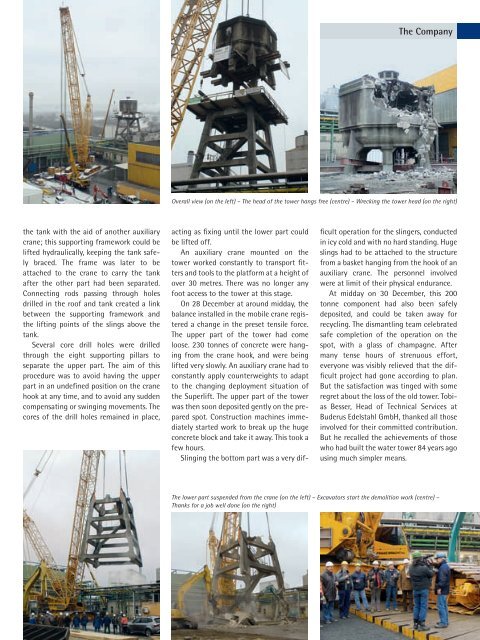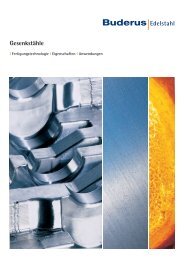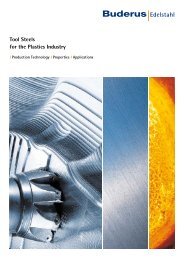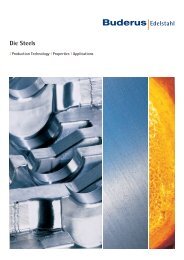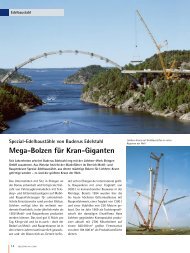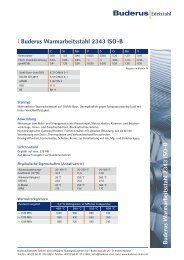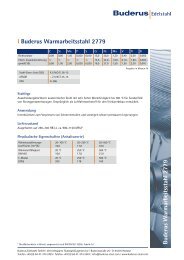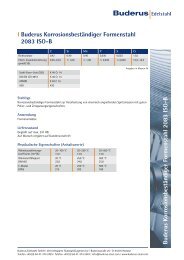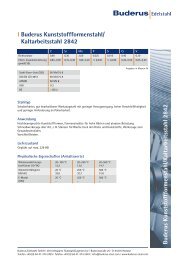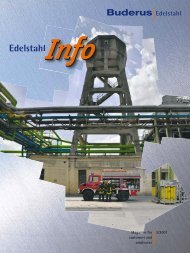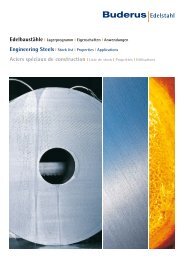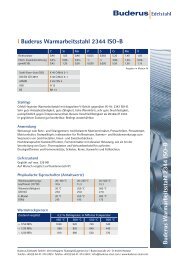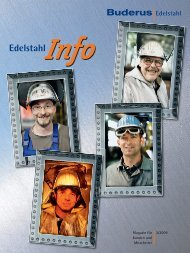Info 1 2008 Engl - Buderus Edelstahl Gmbh
Info 1 2008 Engl - Buderus Edelstahl Gmbh
Info 1 2008 Engl - Buderus Edelstahl Gmbh
Create successful ePaper yourself
Turn your PDF publications into a flip-book with our unique Google optimized e-Paper software.
the tank with the aid of another auxiliary<br />
crane; this supporting framework could be<br />
lifted hydraulically, keeping the tank safely<br />
braced. The frame was later to be<br />
attached to the crane to carry the tank<br />
after the other part had been separated.<br />
Connecting rods passing through holes<br />
drilled in the roof and tank created a link<br />
between the supporting framework and<br />
the lifting points of the slings above the<br />
tank.<br />
Several core drill holes were drilled<br />
through the eight supporting pillars to<br />
separate the upper part. The aim of this<br />
procedure was to avoid having the upper<br />
part in an undefi ned position on the crane<br />
hook at any time, and to avoid any sudden<br />
compensating or swinging movements. The<br />
cores of the drill holes remained in place,<br />
acting as fi xing until the lower part could<br />
be lifted off.<br />
An auxiliary crane mounted on the<br />
tower worked constantly to transport fi tters<br />
and tools to the platform at a height of<br />
over 30 metres. There was no longer any<br />
foot access to the tower at this stage.<br />
On 28 December at around midday, the<br />
balance installed in the mobile crane registered<br />
a change in the preset tensile force.<br />
The upper part of the tower had come<br />
loose. 230 tonnes of concrete were hanging<br />
from the crane hook, and were being<br />
lifted very slowly. An auxiliary crane had to<br />
constantly apply counterweights to adapt<br />
to the changing deployment situation of<br />
the Superlift. The upper part of the tower<br />
was then soon deposited gently on the prepared<br />
spot. Construction machines immediately<br />
started work to break up the huge<br />
concrete block and take it away. This took a<br />
few hours.<br />
Slinging the bottom part was a very dif-<br />
The Company<br />
Overall view (on the left) – The head of the tower hangs free (centre) – Wrecking the tower head (on the right)<br />
fi cult operation for the slingers, conducted<br />
in icy cold and with no hard standing. Huge<br />
slings had to be attached to the structure<br />
from a basket hanging from the hook of an<br />
auxiliary crane. The personnel involved<br />
were at limit of their physical endurance.<br />
At midday on 30 December, this 200<br />
tonne component had also been safely<br />
deposited, and could be taken away for<br />
recycling. The dismantling team celebrated<br />
safe completion of the operation on the<br />
spot, with a glass of champagne. After<br />
many tense hours of strenuous effort,<br />
every one was visibly relieved that the diffi<br />
cult project had gone according to plan.<br />
But the satisfaction was tinged with some<br />
regret about the loss of the old tower. Tobias<br />
Besser, Head of Technical Services at<br />
<strong>Buderus</strong> <strong>Edelstahl</strong> GmbH, thanked all those<br />
involved for their committed contribution.<br />
But he recalled the achievements of those<br />
who had built the water tower 84 years ago<br />
using much simpler means.<br />
The lower part suspended from the crane (on the left) – Excavators start the demolition work (centre) –<br />
Thanks for a job well done (on the right)


